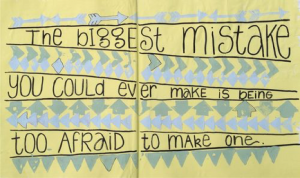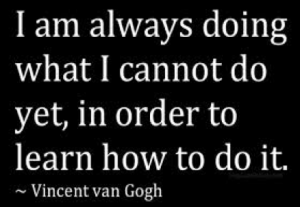Success and Failure in Art
 Winston Churchill is quoted as saying “Success consists of going from failure to failure without loss of enthusiasm.”
Winston Churchill is quoted as saying “Success consists of going from failure to failure without loss of enthusiasm.”
I love that saying but the fact is, it’s extremely hard to maintain a healthy measure of enthusiasm if you never feel good about the way your artwork is turning out!
Even if we understand that failure is part of the learning experience, it’s easy to get discouraged if disaster or even disappoint becomes the norm. It’s easy to set something aside or give up on it when mistakes are made or something is clearly not going the way we expected or envisioned. And keeping our enthusiasm up is even harder if that failure happens time and time again without the experience of having a certain measure of success along the way.
This is where attitude comes into play. Consider the idea that if you were to absolutely love everything you ever created and never experienced any degree of failure you probably would not be stretching yourself, trying new things or taking risks. It’s in that stretching, trying and risk taking that we learn and grow. We can learn from mistakes as well as from our successes. And sometimes whether something is a success or a failure depends on how we look at it.
 If your painting doesn’t look exactly like what you had in mind, or just isn’t what you were striving for, it doesn’t necessarily mean your painting has no merit. If you learned something (whether you love the results or not) the experience is worth quite a bit! Set your pre-conceived ideas of what you were after aside and do some serious evaluating.
If your painting doesn’t look exactly like what you had in mind, or just isn’t what you were striving for, it doesn’t necessarily mean your painting has no merit. If you learned something (whether you love the results or not) the experience is worth quite a bit! Set your pre-conceived ideas of what you were after aside and do some serious evaluating.
Also ask yourself if your expectations are realistic. Are you attempting things that are way beyond your level of ability? (Ability is a combination of knowledge and skill.) If that is the case you are not being fair to yourself and some level of disappointment was inevitable. The best thing in that situation is to set aside the painting that’s causing the discouragement and start with easier pieces. Allow yourself some time to gain more experience and a better understanding of the principles of art and the techniques that are involved before you go back to the painting in question.
If that’s not the problem the next step is to look for the things that are working, look for and identify the things you do like about your painting. Is it just that it’s not what you were after or what you expected that makes you unhappy with it? If that’s what it is there is a pretty good chance that the painting is not really a failure after all and that someone else would love and appreciate the painting for what it is. You might be able to sell it or it might make a wonderful gift.
If it’s more than that, you need to identify exactly what it is that makes you dislike your painting. You need to be much more specific than “it doesn’t look like this or like that”. Start by answering these questions: Is it the colors or a specific color that is bothering you? Is it the lack of form or a lack of depth – and is that overall or in just one area or on one object? Is it a lack of contrast or too much contrast? Is something too rigid, too casual, too messy, or what? Does it lack interest or is something wrong with the composition? Does something seem to be drawn incorrectly or does the perspective seem off? When you know what is wrong – whether it’s one thing or ten things, identifying problem areas and making comparisons is a great learning experience. If you can identify the problems in those terms even if you have no idea how to fix or resolve the problems in the painting it can serve as a learning experience. Identifying the types of things you have problems with helps you to know if taking a class or reading through lessons on a certain subject or similar projects would be helpful to you. The more you learn and apply what you’ve learned from painting to painting, the more you will grow and develop your skills… and with that comes enthusiasm and the true success we all desire! And in the meantime – remember mistakes are good because they pave the pathway to success!!

Leave a Reply